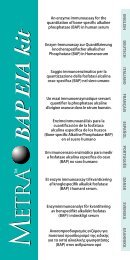Clinical and Technical Review - Tecomedical
Clinical and Technical Review - Tecomedical
Clinical and Technical Review - Tecomedical
Create successful ePaper yourself
Turn your PDF publications into a flip-book with our unique Google optimized e-Paper software.
6<br />
Collagen metabolites <strong>and</strong> epitopes<br />
DPD:<br />
Deoxypyridinoline. Breakdown product from Type I collagen<br />
degradation.<br />
PYD:<br />
Pyridinoline. Breakdown product from Type I collagen<br />
degradation.<br />
NTX:<br />
Cross-linked N-terminal telopeptide resulting from<br />
Type I collagen degradation. NTX = new synthesized <strong>and</strong><br />
agemodified bone matrix.<br />
CTX:<br />
C-terminal telopeptide resulting from Type I collagen<br />
degradation, CTX alpha (New Bone Matrix), CTX beta (Old<br />
Bone Matrix).<br />
ICTP=CTX-MMP:<br />
Carboxy-terminal telopeptide of type I collagen.<br />
Larger epitope containing the smaller CTX epitope.<br />
Helical Peptide:<br />
Peptide derived from the helical region of the α-1 chain of<br />
Type 1 collagen.<br />
Note:<br />
The concentration of the different biomarker are partly<br />
dependent on age, gender, race as well as influenced by<br />
diurnal rhythm, food intake etc. (see table on page 8). Age<br />
dependency is of high importance if biomarker are used for<br />
preclinical testing, especially in juvenile laboratory animals<br />
(rat, mice).<br />
Bone turnover regulators<br />
Calcitonin:<br />
Inhibits bone resorption, directly acts on osteoclasts.<br />
Parathyroid hormone (PTH):<br />
Key factor in the maintenance of calcium <strong>and</strong> phosphate<br />
homeostasis. Stimulates osteoclasts activity.<br />
1,25(OH) 2D3 :<br />
1,25 dihydroxy vitamin D3 (or 1,25-dihydroxycholecalciferol)<br />
is the biologically active form of vitamin D. It is<br />
synthesized in the kidney from 25-vitamin D (25-hydroxycholecalciferol).<br />
1,25(OH) 2D3 is the principal regulator<br />
of calcium homeostasis in the body. It enhances the<br />
efficiency of calcium.<br />
Fetuin A:<br />
Glycoprotein synthesized by liver, secreted into blood.<br />
Deposited as noncollagenous protein in mineralized bones.<br />
Potent inhibitor of soft tissue (vascular) calcification by binding<br />
excess mineral in serum. Regulates calcium metabolism<br />
<strong>and</strong> osteogenesis.<br />
FGF-23:<br />
Fibroblast Growth Factor 23. Important regulator of<br />
phosphate homeostasis. Able to “block” renal reabsorption<br />
of Pi. FGF-23 abnormalities are involved in renal phos-phate<br />
wasting disorders leading to “hypophosphatemia”.<br />
Literature:<br />
1. Leeming DJ, Koizumi M, Byrjalsen I, Li B, Qvist P, Tanko LB.<br />
The relative use of eight collagenous <strong>and</strong> noncollagenous markers<br />
for diagnosis of skeletal metastases in breast, prostate, or<br />
lung cancer patients.<br />
Cancer Epidemiol Biomarkers Prev. 2006; 15(1):32-8.<br />
2. Caulfield MP, Reitz RE. Biochemical markers of bone turnover <strong>and</strong><br />
their utility in osteoporosis. MLO-online April 2004.<br />
Schaller S, Henriksen K, Hoegh-Andersen P, Søndergaard BC,<br />
Sumer EU, Tanko LB, Qvist P <strong>and</strong> Karsdal MA. In vitro, ex vivo, <strong>and</strong><br />
in vivo methodological approaches for studying<br />
therapeutic targets of osteoporosis <strong>and</strong> degenerative joint<br />
diseases: How biomarkers can assist? Assay And Drug<br />
Development Technologies 2005; 3:553-580.<br />
3. Delmas PD, Eastell R, Garnero P, Seibel MJ <strong>and</strong> Stephan J. The use<br />
of biochemical markers of bone turnover in osteoporosis.<br />
Osteoporosis Int 2000: Supp 6: S2-17.



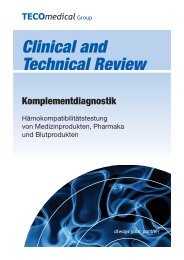
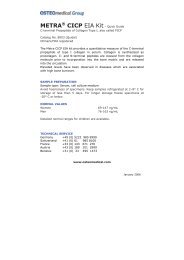
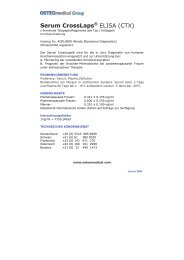
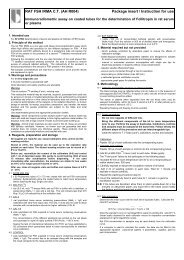


![PTH [Hormone Parathyroïdienne] Intacte ELISA](https://img.yumpu.com/1233682/1/190x245/pth-hormone-parathyroidienne-intacte-elisa.jpg?quality=85)
